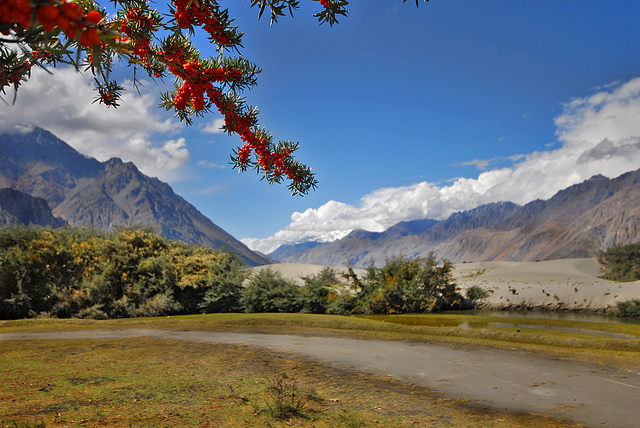Seabuckthorn, the thorny shrub with diverse uses ranging from medicinal to cosmetic, has the potential to change the economy of India’s Himalayan desert region of Ladakh, where it is sometimes referred to as gold but also destroyed as a weed.
Given the fact that the present international market for seabuckthorn products — including foodstuff, beverages, medicines, cosmetics and industrial material – is valued at over US$60 billion a year, it is time for the government to harness production, says Amjid Ali, associate professor at Kashmir University.
“During my research, I found that people in Ladakh harvest it unsustainably as they crush the entire plant for fruit collection. They say that since it is a wild plant, it can be destroyed without bothering about its re-growth,” said Ali, who presented his research paper on seabuckthorn at a conference on sustainable development of resources in Himalayas in Ladakh’s capital Leh held in June.
The leaves, flowers and fruits of the plant, famed for its healing properties, can all be put to use.
The cultivation of seabuckthorn, for which the Himalayas provide the best climatic conditions, can be the future generation eco-friendly crop of the mountains if supported by proper scientific research and technological intervention.
The shrub presently grows wild in Ladakh, at an average altitude of 2,400 metres with scanty vegetation and an average annual rainfall of 50 millimetres, and various other Himalayan regions. It also grows in other Himalayan regions such as parts of Himachal Pradesh, Sikkim, Arunachal Pradesh and Uttarakhand.
Meera Bhat, a researcher at the Tata Institute of Social Sciences in Mumbai, also stresses that seabuckthorn trade must develop into an industry. “This basically means that the current production has to significantly scale up, more value addition done, newer and more secure markets to be explored and more employment opportunities created for the local people. For an initiative [to work] people’s attitudes and government’s policies will have to change.”
Tapping the economic potential
Ali added that the potential of seabuckthorn to boost the economy was yet to be explored as no elite genotype of the plant and its proper characterisation had been done. “Because of ignorance about its economic benefits and the lack of communication between the experts and the farmers, thanks to the absence of any proper government policy on this plant which is popularly known as Ladakh gold, some people even treat it as a weed and remove it from their fields, especially the male plant which has no flowers,” he told scientists at the conference.
Citing the examples of China, Russia, Mongolia and Canada, he said seabuckthorn could change the face of Ladakh too. China, where the area under seabuckthorn cultivation went up from 667,000 hectares in 1985 to one million hectares in 1990, is the largest producer of seabuckthorn products, valued at a little over US$20 million.
In Ladakh, seabuckthorn is grown in 11,000 hectares in the five valleys Leh, Nubra, Zanskar, Suru and Changthang.
The plant species was used for greening the mountainous terrain under the Cold Desert Afforestation Programme during late the 1990s and early 2000s. Seabuckthorn drinks were marketed as herbal beverages under trade names such as Leh Berry, Ladakh Berry and Power Berry.
In her research thesis Exploring the Seabuckthorn Industry in Leh, Ladakh, Bhat has said seabuckthorn processing started as a business with an enterprise, Compact Ltd, rather than a planned effort for developing an industry or organising livelihoods around the plant.
With no proper planning, the supply chain, she said, ended up being a patchwork of sporadic efforts. “So, the first step towards establishing the seabuckthorn industry in Ladakh would be to map the supply chain, understand and identify the gaps and then work towards improving it.”
Apart from the wrangling between various stakeholders and the low prices paid to the seabuckthorn collectors, the tedious process involved in harvesting the crop also plays a role. “Since seabuckthorn is a very bushy plant, it becomes impossible to wade through the bush to collect as a result of which berries can only be collected from the periphery,” Bhat has observed.
“If pathways can be made, a greater quantity of berries could be collected from a smaller area.”
The spines on the plant, Ali said, are a serious impediment to harvesting the fruit and the search for “spineless plants” found naturally as well as through research on induced mutation should be intensified.
Detailed studies on reproductive biology, pollination ecology and seed-to-seed cycle need to be carried out, the researcher said.
In their paper on value of seabuckthorn for biodiversity conservation in the Himalayas, Soman Acharya and others write that the plant plays an important role in soil erosion control, slope stabilisation and the reclamation of degraded and wastelands. There are also “ample opportunities to bring change in the livelihoods of high mountain people by utilising this kind of hidden treasure in Himalayas,” the paper reads.

